
SNK Corporation is a Japanese video game hardware and software company. It is the successor to the company Shin Nihon Kikaku and presently owns the SNK video game brand and the Neo Geo video game platform, and electronics. SNK's predecessor Shin Nihon Kikaku Corporation was founded in 1978 by Eikichi Kawasaki. In 1981, the name was informally shortened to SNK Corporation, which became the company's official name in 1986.

Final Fight 2 is a 1993 side-scrolling beat 'em up video game released by Capcom for the Super Nintendo Entertainment System. It is the direct sequel to the 1989 coin-operated arcade game Final Fight, which was previously also released for the SNES. Final Fight 2 was developed by Capcom's consumer division with no preceding coin-op version. The game was re-released onto Wii's Virtual Console service in 2009 for the North American and European regions.

The Legend of Kage is a side-scrolling hack-and-slash game developed and published by Taito in 1985. In this game, the player controls the ninja Kage, with the objective being to get through five stages in order to save the pincess Kirihime. These stages are littered with enemies, however Kage has various skills and weapons on his hands in order to get through them.

Fatal Fury 2, known as Garō Densetsu 2: Aratanaru Tatakai in Japan, is a 1992 fighting video game released by SNK for the Neo Geo arcade and home platforms, and later ported to several other home systems. It is the sequel to Fatal Fury: King of Fighters (1991) and the second game in the Fatal Fury franchise. Its updated version, Fatal Fury Special, was released in 1993.

Fatal Fury Special, known as Garō Densetsu Special in Japan, is a 1993 fighting game developed and published by SNK and originally released for the Neo Geo arcade and home platforms. It is an updated version of 1992's Fatal Fury 2, introducing several changes to the gameplay system while expanding the available character roster.
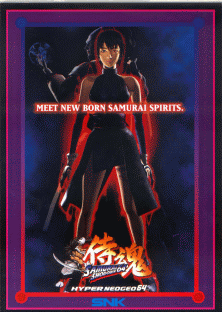
Samurai Shodown 64, known as Samurai Spirits in Japan, is a 3D fighting game produced by SNK for its Hyper Neo-Geo 64 system. It was SNK's first 3D fighting game. After having released four Samurai Shodown games on the Neo-Geo, SNK announced that they would be producing a new arcade hardware platform, this one 64-bit and with extensive 3D capabilities. Although it was never ported to home consoles, it was followed by a second 3D installment titled Samurai Shodown 64: Warriors Rage.

Samurai Shodown II, known in Japan as Shin Samurai Spirits: Haōmaru Jigokuhen, is a 1994 fighting game released as the second entry in SNK's Samurai Shodown series. Like the original Samurai Shodown, the sequel was initially released for the Neo Geo arcade and home system.

World Heroes 2 is a 1993 fighting arcade game developed and published by ADK with the assistance of SNK. It was originally released for the Neo Geo MVS arcade cabinet on April 26, 1993. It is the sequel to the 1992 fighting arcade game World Heroes, as well as the second title of the World Heroes series. It was even the first game with the "ADK" logo labeled within the game after the developer changed from its previous name "Alpha Denshi"; however, the "Alpha" logo was last used on one of the arcade flyers of World Heroes 2.

Karnov's Revenge is a 1994 fighting game developed by Data East, released for the Neo Geo. It is the second game in the Fighter's History series. The game was later ported to the Neo Geo, Neo Geo CD and Sega Saturn home consoles.
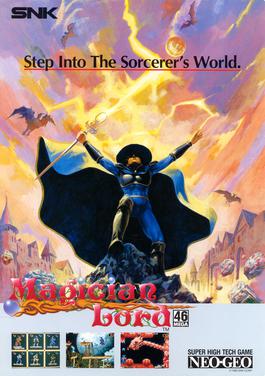
Magician Lord is a side-scrolling action-platform arcade video game developed by Alpha Denshi and originally published by SNK on April 26, 1990. It was one of the launch titles for both the Neo Geo MVS (arcade) and Neo Geo AES (home) platforms, in addition of also being one of the pack-in games for the AES.

Neo Geo is a family of video game hardware that was developed by SNK. On the market from 1990 to 2004, the brand originated with the release of an arcade system, the Neo Geo Multi Video System (MVS) and its home console counterpart, the Neo Geo Advanced Entertainment System (AES).

Ninja Master's: Haō Ninpō Chō,, is a ninja-themed 2D fighting game produced by ADK and originally released in 1996 for the Neo Geo arcade and home platform. Ninja Master's was the sixth and final fighting game produced by ADK, following the four games in the World Heroes series and Aggressors of Dark Kombat. It was later featured in the 2008 compilation ADK Damashii for the PlayStation 2. Ninja Master's was also re-released on the Neo-Geo X handheld system in 2012, and for the Virtual Console in 2013. In 2019 it was released as part of Arcade Archives developed by Japanese company Hamster. As of 2021, Ninja Master's was released worldwide on Nintendo Switch and Xbox One. The PS4 version remains exclusive to Asia but includes both Japanese and English releases.

Ninja Commando is a vertically scrolling run and gun video game developed by Alpha Denshi and published by SNK for the Neo Geo arcade and home systems in 1992. It was released for the Neo Geo CD in 1994.
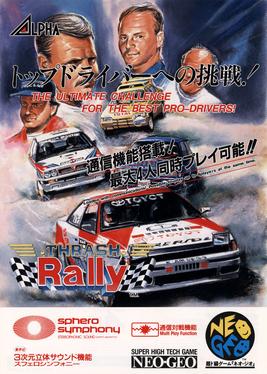
Thrash Rally is a top-down perspective rally racing video game developed by ADK and released by SNK Corporation for the Neo Geo system. It was released by SNK on December 20, 1991 and would be followed by an spiritual successor in 1996, Over Top.

Samurai Shodown, known in Japan as Samurai Spirits, is a fighting game developed and published by SNK for the Neo Geo arcade and home platform. Released in 1993, it is the first installment in the Samurai Shodown series. In contrast to other fighting games at the time, which were set in modern times and focused primarily on hand-to-hand combat, Samurai Shodown is set in feudal-era Japan and was SNK's first arcade fighting game to focus primarily on weapon-based combat.
SNK vs. Capcom: Card Fighters Clash is a series of SNK Playmore games between 1999 and 2006 for hand-held consoles. It is a digital collectible card game, spun off from the popular series of fighting games by SNK and Capcom, and also including references to many other kinds of games from both companies. The game uses cards based on Capcom and SNK characters from a variety of earlier games. The first two versions of this game were released for the Neo Geo Pocket Color, and a new version for the Nintendo DS was released in 2007.
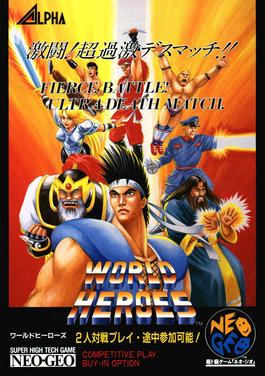
World Heroes is a 1992 fighting arcade game developed and published by Alpha Denshi with the assistance of SNK. It was originally released for the Neo Geo MVS arcade cabinet on July 28, 1992. It is ADK's first game in the fighting game genre, as well as their earliest attempt in the fighting game trend of the '90s that was popularized by Capcom's 1991 arcade hit Street Fighter II. It was even the last game with the "Alpha" logo labeled within the game before the developer became "ADK"; however, the "Alpha" logo was last used on one of the arcade flyers of its sequel.
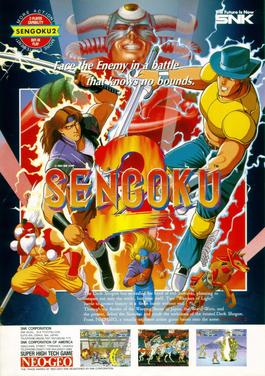
Sengoku 2 is a 1993 beat 'em up arcade game developed and published by SNK, and it is the second game of the Sengoku series. It was first released for the Neo Geo and Neo Geo CD consoles. In 2009 the series was compiled on a CD titled Sengoku Anthology for the PlayStation 2 and Windows. The Neo Geo version was re-released on the Virtual Console for the Wii in Japan on November 8, 2012, and in the PAL region on February 7, 2013. In 2017, the game was re-released as part of the ACA Neo Geo series for the Xbox One, followed by the PlayStation 4, Nintendo Switch and Microsoft Windows PCs via Steam the following year.
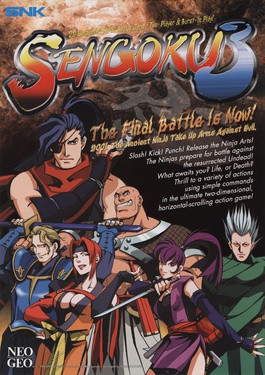
Sengoku 3 is a 2001 side-scrolling beat 'em up arcade video game developed by Noise Factory and published by SNK. It is the third and final entry in the Sengoku series. In the game, players battle against undead enemy spirits. Though initially launched for the Neo Geo MVS (arcade), the title was later released to Neo Geo AES (home), in addition of being re-released through download services for various consoles. It was met with positive reception from critics and reviewers since its initial release.



















